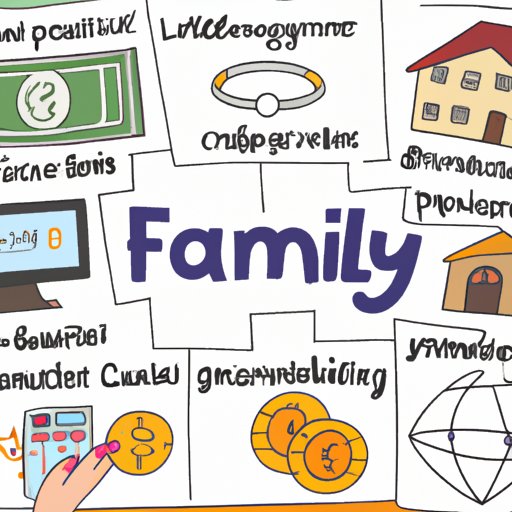Introduction
Financial literacy is a key component of any educational setting. Teaching children the basics of money management at an early age can help them develop the necessary skills to make sound financial decisions throughout their lives. However, teaching financial literacy to elementary school students can be a challenging task. This article will explore some strategies that teachers can use to effectively teach financial literacy to elementary students.
Overview of the Problem
In recent years, there has been an increased focus on teaching financial literacy in schools. Research suggests that students who are taught basic financial concepts such as budgeting, savings, investing, and credit management are more likely to make better financial decisions later in life. Despite this, many elementary schools still lack adequate financial literacy instruction. Without proper guidance, students may not understand the importance of financial literacy or develop the necessary skills to manage their finances.
Purpose of the Article
The purpose of this article is to provide teachers with strategies for teaching financial literacy to elementary school students. The strategies outlined in this article can be used to help elementary students develop an understanding of basic financial concepts and the skills needed to make informed financial decisions. By implementing these strategies, teachers can help ensure that their students have the knowledge and skills to make responsible financial choices throughout their lives.
Utilizing Games and Activities
One of the best ways to teach financial literacy to elementary students is through the use of games and activities. Incorporating fun activities into lessons can help keep students engaged and encourage them to learn more about financial literacy. Additionally, playing games can help students practice and apply the concepts they’ve learned in a safe and low-pressure environment.
Making Financial Literacy Fun
When teaching financial literacy to elementary students, it’s important to make the topic fun and interesting. Incorporating activities such as board games, card games, and puzzles can help keep students engaged and make learning more enjoyable. Additionally, using props such as play money or coins can help bring the lesson to life and make it easier for students to understand the concepts.
Examples of Games and Activities
There are many different types of games and activities that can be used to teach financial literacy to elementary students. For example, Monopoly is a great game for teaching budgeting and decision-making skills. Other popular games include Money Bingo, Money Match, and Cash Flow 101. Additionally, teachers can create their own games and activities to make learning more interactive and engaging.
Introducing Real-World Examples
Another effective way to teach financial literacy to elementary students is by introducing real-world examples. Discussing everyday money matters can help students understand how their financial decisions can affect their lives. Additionally, discussing current events related to financial topics can provide students with context and help them understand the importance of financial literacy.
Discussing Everyday Money Matters
Talking about everyday money matters can help students understand how their financial decisions can impact their lives. For example, discussing topics such as budgeting, saving, and spending can help students understand the importance of making sound financial decisions. Additionally, discussing topics such as taxes, insurance, and investing can help students understand how their money can work for them.
How to Show Children Real-World Examples
When introducing real-world examples, it’s important to keep the discussion simple and age-appropriate. For younger students, it may be helpful to use stories or illustrations to explain concepts. Additionally, teachers can invite guest speakers to discuss topics such as budgeting, investing, and credit management. Finally, teachers can assign research projects to help students explore topics in greater depth.
Incorporating Technology
Incorporating technology into lessons can be a great way to engage students and make learning more interactive. Technology can also provide teachers with a variety of resources to use when teaching financial literacy. From online games and apps to virtual reality simulations, technology can be a powerful tool for teaching financial literacy.
Benefits of Using Technology
Using technology in the classroom can help make learning more engaging and enjoyable for students. Technology can also provide students with access to a variety of resources and tools that can help them learn more about financial literacy. Additionally, technology can help teachers track student progress and offer personalized instruction.
Examples of Technology Resources
There are many technology resources available for teaching financial literacy to elementary students. Popular resources include online games and apps such as Counting Coins, Money Island, and Financially Fit Kids. Additionally, virtual reality simulations such as Banktivity and Investopedia can help students explore various financial concepts in a safe and realistic environment. Teachers can also use websites such as Khan Academy and EverFi to access lessons and activities.
Engaging Parents
Engaging parents can be an effective way to reinforce the lessons taught in the classroom. Involving parents in their child’s education can help ensure that students receive consistent support at home. Additionally, working with parents can provide teachers with valuable insight into how students are learning and what types of activities and resources are most effective.

Why Involvement from Parents is Important
Involvement from parents is essential for teaching financial literacy to elementary students. Parents can provide students with additional support and guidance outside of the classroom. Additionally, parents can serve as role models and demonstrate how to make smart financial decisions. Finally, parents can help reinforce the lessons taught in the classroom and encourage their children to take an active interest in financial literacy.

Resources and Opportunities for Parents
There are many resources and opportunities available for parents who want to get involved in their child’s financial literacy education. For example, many financial institutions offer free classes and seminars designed to teach parents about money management. Additionally, there are many websites and blogs dedicated to helping parents teach their children about money. Finally, many schools offer parent-student workshops where parents and students can learn together.
Creating a Budgeting Project
Creating a budgeting project is another great way to teach financial literacy to elementary students. Budgeting projects can help students practice and apply the concepts they’ve learned in the classroom. Additionally, budgeting projects can give students a better understanding of how their financial decisions can affect their lives.
Practicing and Applying Financial Literacy Skills
Creating a budgeting project is a great way for students to practice and apply the financial literacy skills they’ve learned in the classroom. Through a budgeting project, students can learn how to set financial goals, create a budget, track expenses, and make adjustments as needed. Additionally, budgeting projects can help students understand the importance of financial planning and how to make responsible financial decisions.
How to Create a Budgeting Project
Creating a budgeting project is relatively simple. First, teachers should provide students with a list of items they need to purchase, such as food, clothing, and entertainment. Next, students should create a budget based on the items they need to purchase and the amount of money they have available. Finally, students should track their expenses and adjust their budget as needed. Throughout the project, teachers should provide guidance and support to help students stay on track and make responsible financial decisions.
Making it Personal
Making financial literacy personal can help students understand and relate to the topics being discussed. Encouraging students to think about their own financial future can help them understand the importance of making sound financial decisions. Additionally, exploring possible outcomes of various financial decisions can help students understand the consequences of their actions.

Encouraging Students to Think Ahead
Encouraging students to think ahead can help them understand the importance of making responsible financial decisions today. For example, teachers can ask students to consider how their financial decisions now may affect their future. Additionally, teachers can ask students to think about the long-term effects of their decisions and how they can prepare for the future.
Exploring Possible Outcomes
Exploring possible outcomes of various financial decisions can help students understand the consequences of their actions. For example, teachers can ask students to consider the potential outcomes of spending too much money or saving too little. Additionally, teachers can ask students to think about what would happen if they invested their money wisely or made poor investment decisions.
Conclusion
Financial literacy is an important part of any educational setting. Teaching financial literacy to elementary school students can be challenging, but there are many strategies that teachers can use to effectively teach the topic. Utilizing games and activities, introducing real-world examples, incorporating technology, engaging parents, and creating a budgeting project can all help teachers teach financial literacy to elementary students. By implementing these strategies, teachers can help ensure that their students have the knowledge and skills to make responsible financial decisions throughout their lives.
(Note: Is this article not meeting your expectations? Do you have knowledge or insights to share? Unlock new opportunities and expand your reach by joining our authors team. Click Registration to join us and share your expertise with our readers.)
